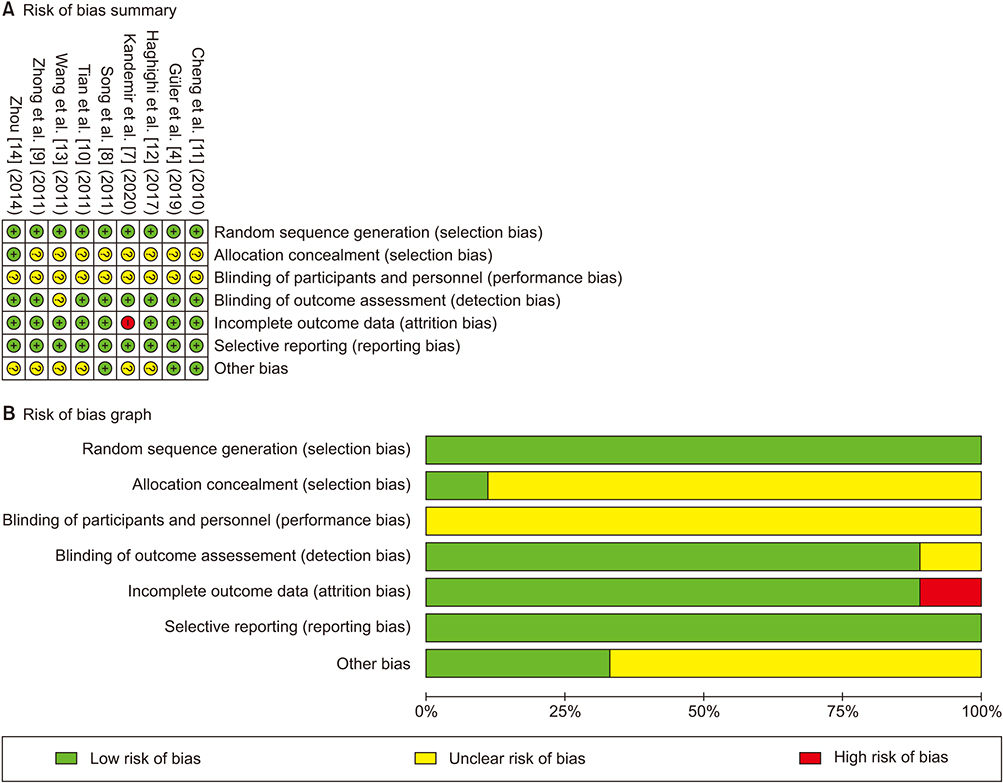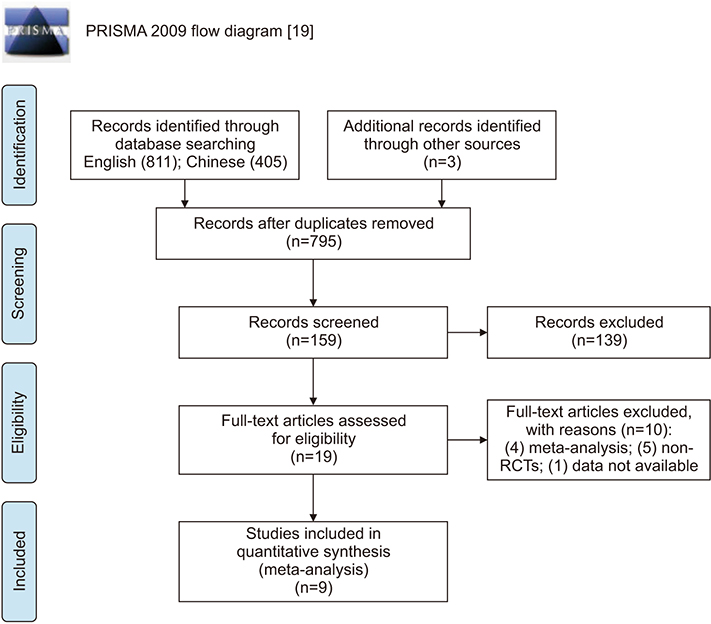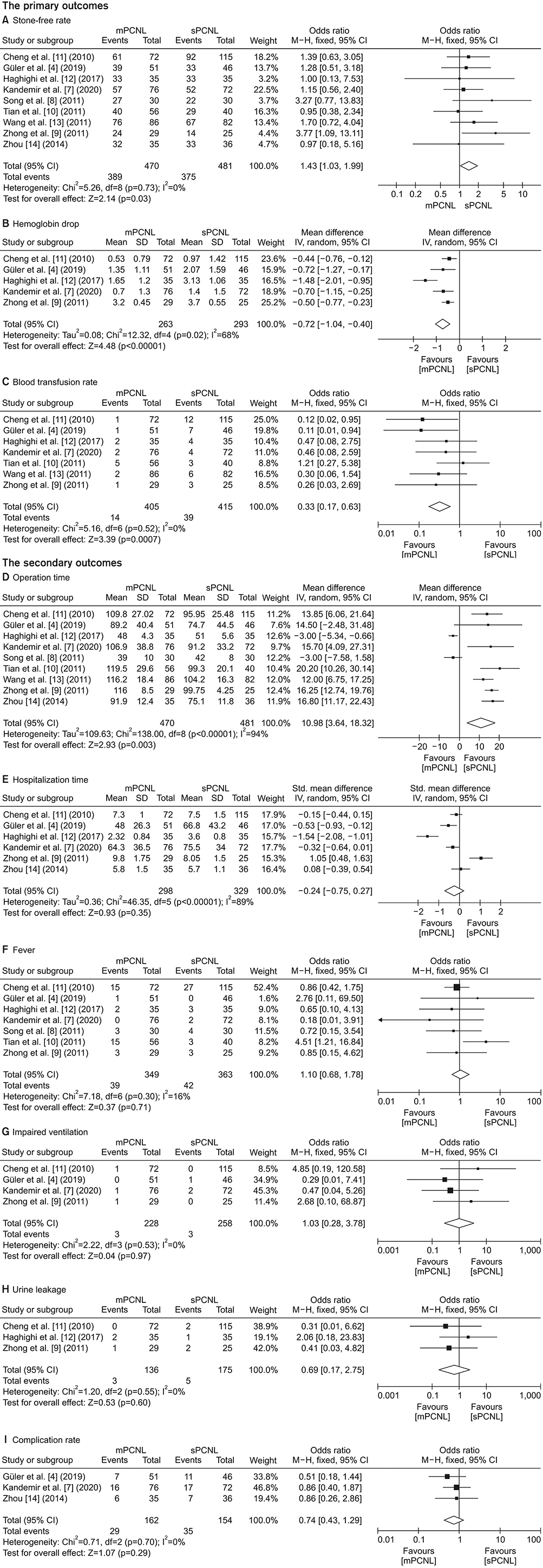Investig Clin Urol.
2020 Mar;61(2):115-126. 10.4111/icu.2020.61.2.115.
The efficacy and safety of miniaturized percutaneous nephrolithotomy versus standard percutaneous nephrolithotomy: A systematic review and meta-analysis of randomized controlled trials
- Affiliations
-
- 1Department of Urology, Institute of Urology, West China Hospital, Sichuan University, Chengdu, China. xweiwch@126.com
- KMID: 2471067
- DOI: http://doi.org/10.4111/icu.2020.61.2.115
Abstract
- PURPOSE
Our aim was to assess the efficacy and safety of miniaturized percutaneous nephrolithotomy (mPCNL) versus standard PCNL (sPCNL) to provide higher-level evidence.
MATERIALS AND METHODS
Eligible randomized controlled trials were identified from electronic databases. The data analysis was performed by the Cochrane Collaboration's software RevMan 5.3.
RESULTS
A total of 1,219 patients from 9 articles published between 2004 and 2019 were included. Compared with those who received sPCNL, patients who received mPCNL experienced a higher stone-free rate (SFR) (odds ratio [OR], 1.43; 95% confidence interval [CI], 1.03-1.99; p=0.03), lower transfusion rates (OR, 0.33; 95% CI, 0.17-0.63; p=0.0007), and lower drops in hemoglobin (mean difference [MD], −0.72; 95% CI, −1.04 to −0.40; p<0.00001), but the operative time seemed to be significantly longer (MD, 10.98; 95% CI, 3.64-18.32; p=0.003). Of note, there was no significant difference between the two groups regarding the SFR (p=0.09) for renal calculi ≥2 cm. In addition, the meta-analysis results showed no significant differences between the groups regarding urine leakage (p=0.60), postoperative fever (p=0.71), impaired ventilation (p=0.97), or total complications (p=0.29) with no heterogeneity between trials. These results remain unaffected with regard to renal calculi ≥2 cm.
CONCLUSIONS
Our findings suggested that mPCNL had a higher SFR than sPCNL and there was no significant difference between the two groups for renal stones ≥2 cm. Besides, mPCNL tended to be associated with significantly less bleeding and a lower transfusion rate, but the duration of the procedure seemed to be significantly longer.
Keyword
MeSH Terms
Figure
Reference
-
1. Türk C, Skolarikos A, Neisius A, Petřík A, Seitz C, Thomas K. Guidelines on urolithiasis [Internet]. Netherlands: European Association of Urology;2019. 11. 08. cited 2019 Nov 8. Available from: https://uroweb.org/guideline/urolithiasis/#note_259.2. Kukreja R, Desai M, Patel S, Bapat S, Desai M. Factors affecting blood loss during percutaneous nephrolithotomy: prospective study. J Endourol. 2004; 18:715–722.3. Jackman SV, Docimo SG, Cadeddu JA, Bishoff JT, Kavoussi LR, Jarrett TW. The "mini-perc" technique: a less invasive alternative to percutaneous nephrolithotomy. World J Urol. 1998; 16:371–374.
Article4. Güler A, Erbin A, Ucpinar B, Savun M, Sarilar O, Akbulut MF. Comparison of miniaturized percutaneous nephrolithotomy and standard percutaneous nephrolithotomy for the treatment of large kidney stones: a randomized prospective study. Urolithiasis. 2019; 47:289–295.
Article5. Zhu W, Liu Y, Liu L, Lei M, Yuan J, Wan SP, et al. Minimally invasive versus standard percutaneous nephrolithotomy: a meta-analysis. Urolithiasis. 2015; 43:563–570.
Article6. Moher D, Shamseer L, Clarke M, Ghersi D, Liberati A, Petticrew M, et al. ; PRISMA-P Group. Preferred reporting items for systematic review and eta-analysis protocols (PRISMA-P) 2015 statement. Syst Rev. 2015; 4:1.
Article7. Kandemir E, Savun M, Sezer A, Erbin A, Akbulut MF, Sarılar Ö. Comparison of miniaturized percutaneous nephrolithotomy and standard percutaneous nephrolithotomy in secondary patients: a randomized prospective study. J Endourol. 2020; 34:26–32.
Article8. Song L, Chen Z, Liu T, Zhong J, Qin W, Guo S, et al. The application of a patented system to minimally invasive percutaneous nephrolithotomy. J Endourol. 2011; 25:1281–1286.
Article9. Zhong W, Zeng G, Wu W, Chen W, Wu K. Minimally invasive percutaneous nephrolithotomy with multiple mini tracts in a single session in treating staghorn calculi. Urol Res. 2011; 39:117–122.
Article10. Tian X, Wan F, Liu D, Wang Z, Ge F. Comparison of standard and minimally invasive percutaneous nephrolithotomy for the treatment of complicated renal calculi. China Foreign Med Treat. 2011; 30:38–39.11. Cheng F, Yu W, Zhang X, Yang S, Xia Y, Ruan Y. Minimally invasive tract in percutaneous nephrolithotomy for renal stones. J Endourol. 2010; 24:1579–1582.
Article12. Haghighi R, Zeraati H, Ghorban Zade M. Ultra-mini-percutaneous nephrolithotomy (PCNL) versus standard PCNL: a randomised clinical trial. Arab J Urol. 2017; 15:294–298.
Article13. Wang XQ, Wang CX, Hao YY. The comparison of minimally invasive tract and standard tract in percutaneous nephrolithotomy for renal stones. Eur Urol Suppl. 2011; 10:70–71.14. Zhou J. Comparison of standard and minimally invasive percutaneous nephrolithotomy for the treatment of renal calculi. Med Forum. 2014; (25):3383–3384.15. Hozo SP, Djulbegovic B, Hozo I. Estimating the mean and variance from the median, range, and the size of a sample. BMC Med Res Methodol. 2005; 5:13.
Article16. Yang L, Wang G, Du Y, Ji B, Zheng Z. Remote ischemic preconditioning reduces cardiac troponin I release in cardiac surgery: a meta-analysis. J Cardiothorac Vasc Anesth. 2014; 28:682–689.
Article17. Higgins JP, Thompson SG, Deeks JJ, Altman DG. Measuring inconsistency in meta-analyses. BMJ. 2003; 327:557–560.
Article18. Higgins JP, Thompson SG. Quantifying heterogeneity in a meta-analysis. Stat Med. 2002; 21:1539–1558.
Article19. Moher D, Liberati A, Tetzlaff J, Altman DG. PRISMA Group. Preferred reporting items for systematic reviews and meta-analyses: the PRISMA statement. PLoS Med. 2009; 6:e1000097.
Article20. Dindo D, Demartines N, Clavien PA. Classification of surgical complications: a new proposal with evaluation in a cohort of 6336 patients and results of a survey. Ann Surg. 2004; 240:205–213.21. Fernström I, Johansson B. Percutaneous pyelolithotomy. A new extraction technique. Scand J Urol Nephrol. 1976; 10:257–259.22. El-Nahas AR, Shokeir AA, El-Assmy AM, Shoma AM, Eraky I, El-Kenawy MR, et al. Colonic perforation during percutaneous nephrolithotomy: study of risk factors. Urology. 2006; 67:937–941.
Article23. Mishra S, Sharma R, Garg C, Kurien A, Sabnis R, Desai M. Prospective comparative study of miniperc and standard PNL for treatment of 1 to 2 cm size renal stone. BJU Int. 2011; 108:896–899. discussion 899–900.24. Seitz C, Desai M, Häcker A, Hakenberg OW, Liatsikos E, Nagele U, Tolley D. Incidence, prevention, and management of complications following percutaneous nephrolitholapaxy. Eur Urol. 2012; 61:146–158.
Article





